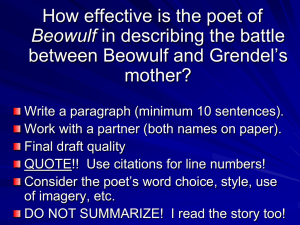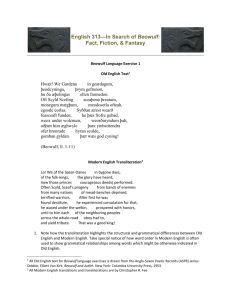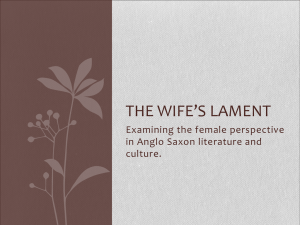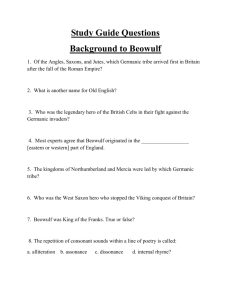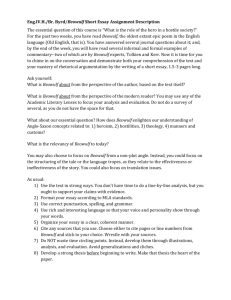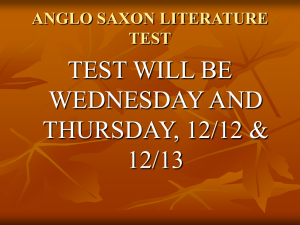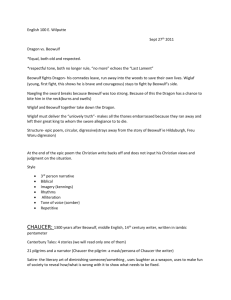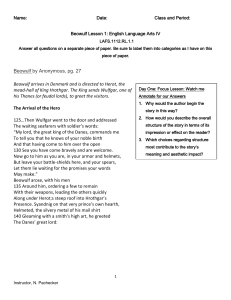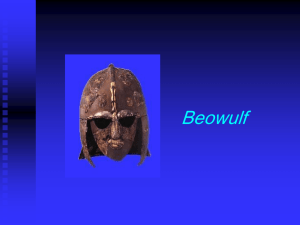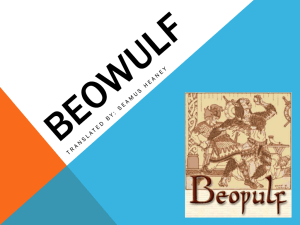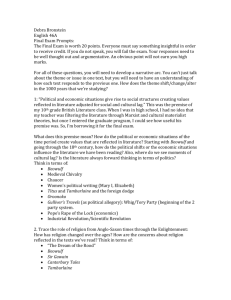Exam Review.
advertisement
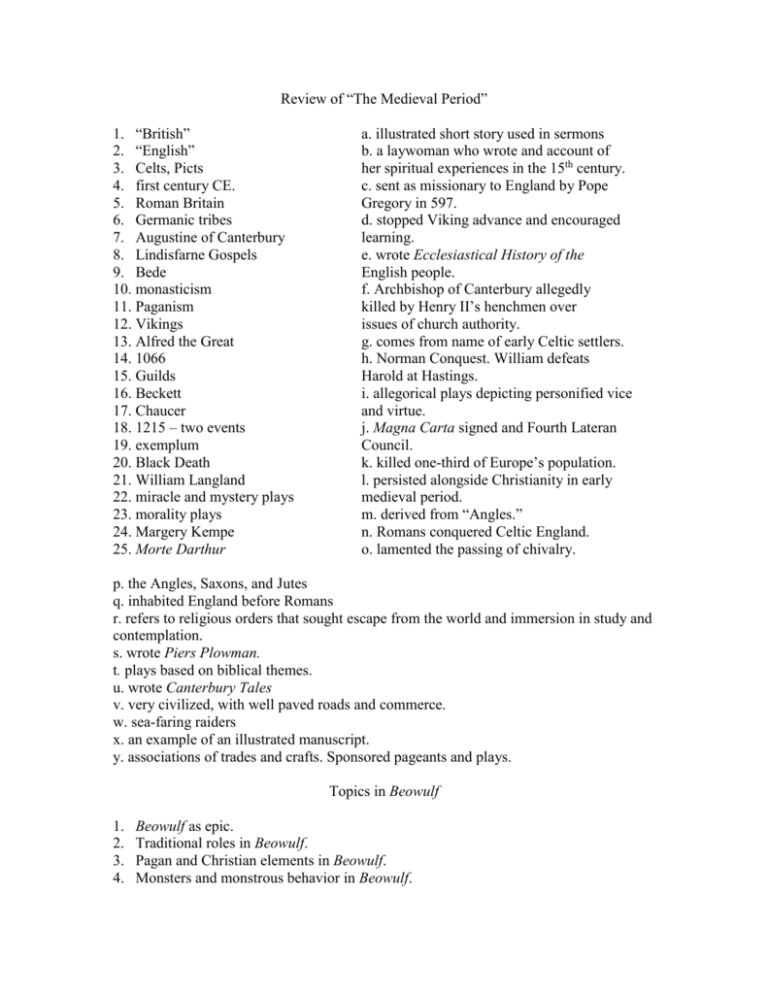
Review of “The Medieval Period” 1. “British” 2. “English” 3. Celts, Picts 4. first century CE. 5. Roman Britain 6. Germanic tribes 7. Augustine of Canterbury 8. Lindisfarne Gospels 9. Bede 10. monasticism 11. Paganism 12. Vikings 13. Alfred the Great 14. 1066 15. Guilds 16. Beckett 17. Chaucer 18. 1215 – two events 19. exemplum 20. Black Death 21. William Langland 22. miracle and mystery plays 23. morality plays 24. Margery Kempe 25. Morte Darthur a. illustrated short story used in sermons b. a laywoman who wrote and account of her spiritual experiences in the 15th century. c. sent as missionary to England by Pope Gregory in 597. d. stopped Viking advance and encouraged learning. e. wrote Ecclesiastical History of the English people. f. Archbishop of Canterbury allegedly killed by Henry II’s henchmen over issues of church authority. g. comes from name of early Celtic settlers. h. Norman Conquest. William defeats Harold at Hastings. i. allegorical plays depicting personified vice and virtue. j. Magna Carta signed and Fourth Lateran Council. k. killed one-third of Europe’s population. l. persisted alongside Christianity in early medieval period. m. derived from “Angles.” n. Romans conquered Celtic England. o. lamented the passing of chivalry. p. the Angles, Saxons, and Jutes q. inhabited England before Romans r. refers to religious orders that sought escape from the world and immersion in study and contemplation. s. wrote Piers Plowman. t. plays based on biblical themes. u. wrote Canterbury Tales v. very civilized, with well paved roads and commerce. w. sea-faring raiders x. an example of an illustrated manuscript. y. associations of trades and crafts. Sponsored pageants and plays. Topics in Beowulf 1. 2. 3. 4. Beowulf as epic. Traditional roles in Beowulf. Pagan and Christian elements in Beowulf. Monsters and monstrous behavior in Beowulf. 5. Community values and legal issues. Literary characteristics of Beowulf 1. Alliteration – the repetition of similar sounds. In Old English, each metrical line consisted of two half-lines separated by a caesura (a stop or pause). Each half line contains two stresses of which either/both the first and second stress must alliterate with the third. 2. Formula – a conventional phrase used as a transition or description to fill the meter or give the poet (scop) time to remember what comes next: “Beowulf spoke, son of Ecgtheow” (529). 3. Epithet – a descriptive word or phrase associated with a figure. “Wielder of Glory” for God is an example. 4. Kenning – a metaphoric compounded phrase, made up of two unrelated elements: “whale’s riding” for sea. 5. Motif – a repeated story element: warriors putting on their gear before battle. 6. Digression – a break in the story line that may describe in detail the history of various props, the ancestry of a warrior, or a story within a story. They may foreshadow events or teach some lesson. Open Book Quiz Multiple Choice 1. Beowulf means A. Big grip B. Bee lion C. Bear D. Young Warrior. 2. Gaining immortality through fame is A. Biblical Salvation B. Calvinism C. the heroic ideal D. tragedy. 3. The insulting retainer who questioned Beowulf’s prowess and reputation is A. Wyglaf B. Hygelac C. Unferth D. Egthoeow 4. “__________ often spares an undoomed man.” A. Wyrd B. God C. Grace D. Tragedy. 5. “Ubi Sunt?” means A. “What does it mean?” B. “Where are they?” C. “What did you do?” D. “What would Wyrd do?” 6. Which of the following is a kenning? A. Deep ocean B. Wave Cutter C. Surfer boy D. Sick person. 7. Beowulf kills Grendel with A. a sword B. a kiss C. a curse D. his bare hands. Identify the following Pilgrims from The Canterbury Tales: 8. 9. 10. 11. 12. 13. 14. 15. 16. 17. He has a sore on his leg. It snows meat and drink in his house. He is familiar with every cause of sickness. She has had five husbands. He is rich in holy thought and work. He is a gelding or a mare. His motto is “If gold rusts, what will happen to iron?” He has been in fifteen mortal battles. He sleeps less than the nightingale. He sings bass to the Pardoner’s tenor. 18. Her motto is “Love conquers all.” 19. He makes men walk the plank. 20. His name is Harry Bailey. Discuss two of the following topics in a short paragraph each: 1. Margery Kempe’s behavior : was it pathological, genuinely mystical, or a sane and deliberate effort to exert power? 2. The Lateran Council resulted in a mixture of reform and intolerance. 3. Her decision to remain unmarried was a both a shrewd political strategy and a failure on the part of Elizabeth I. 4. Protestantism led to the accelerated development of capitalism. Define Renaissance. List several items of debate between Protestantism and Catholicism during the Renaissance. Luther Calvin Henry VIII Be familiar with the following works in addition to the ones above: Sonnet 11 – Wyatt (550) Ballad 80 – Wyatt (552) Sonnets 20, 73, 116 – Shakespeare (791-798). “Woman’s Constancy” – Donne (905-906) “To the Virgins” – Herrick (944) “To His Coy Mistress” – Marvell (962-3) “To My Excellent Lucasia” and “Friendship’s Mystery” – Phillips (973-4) Sonnets 19, 23 – Milton (987) Aeropagitica – Milton (988-995)
